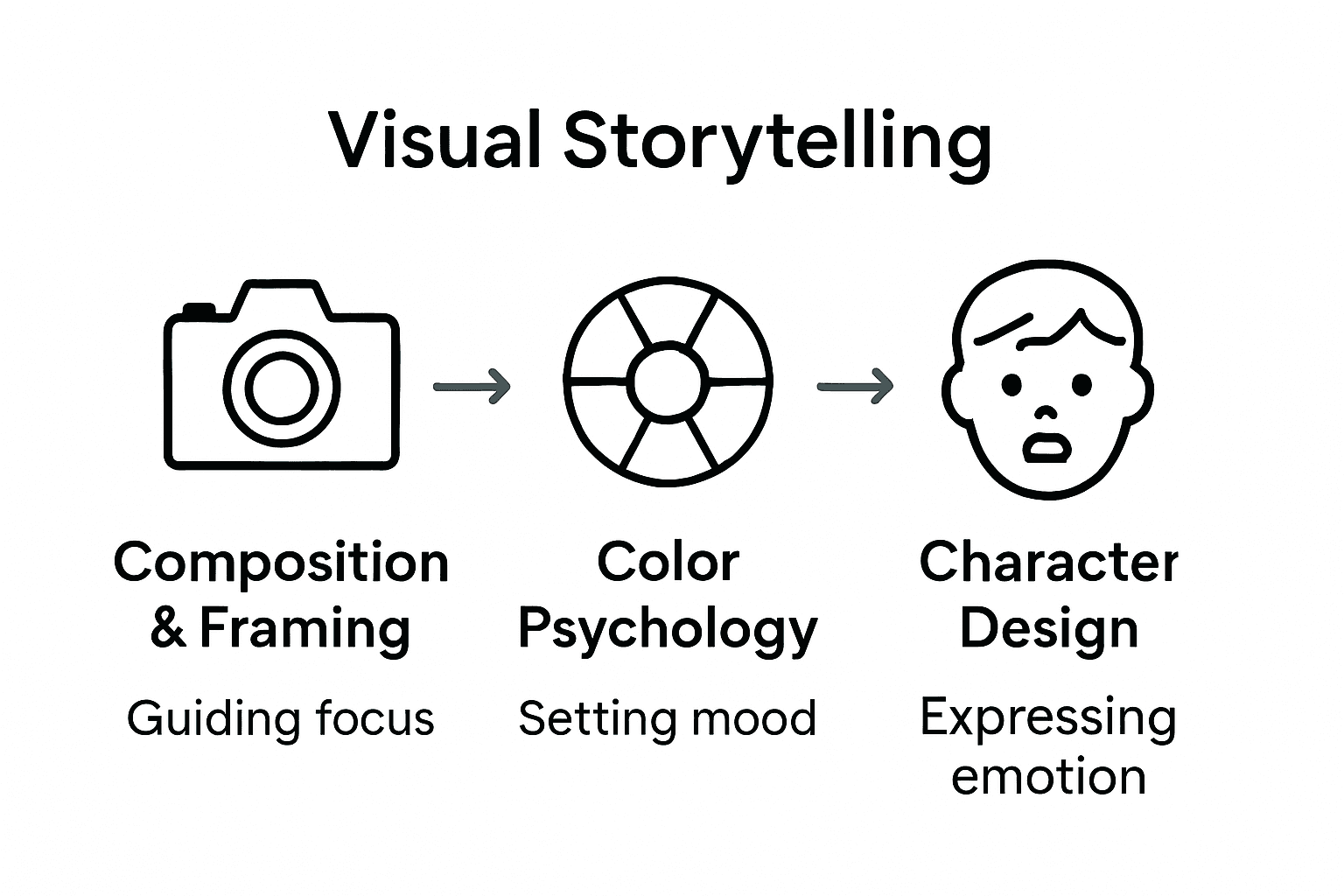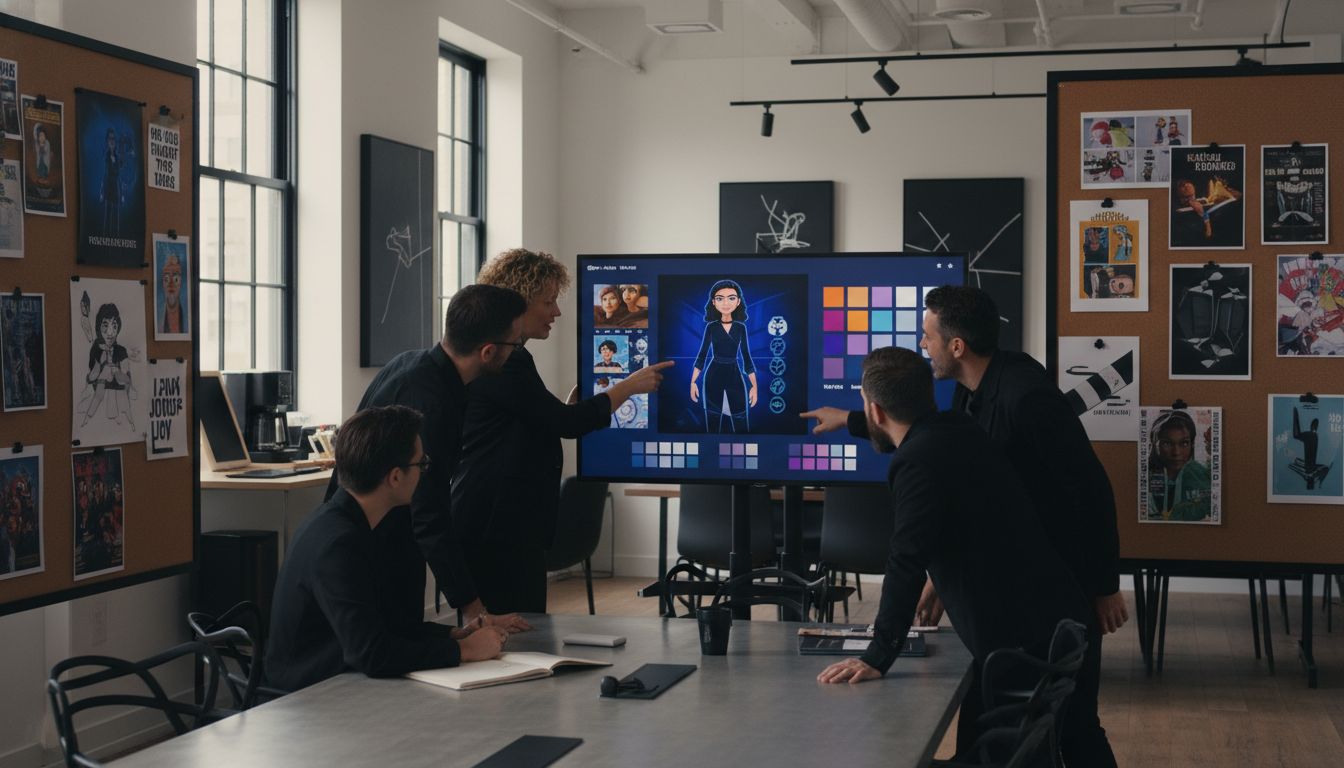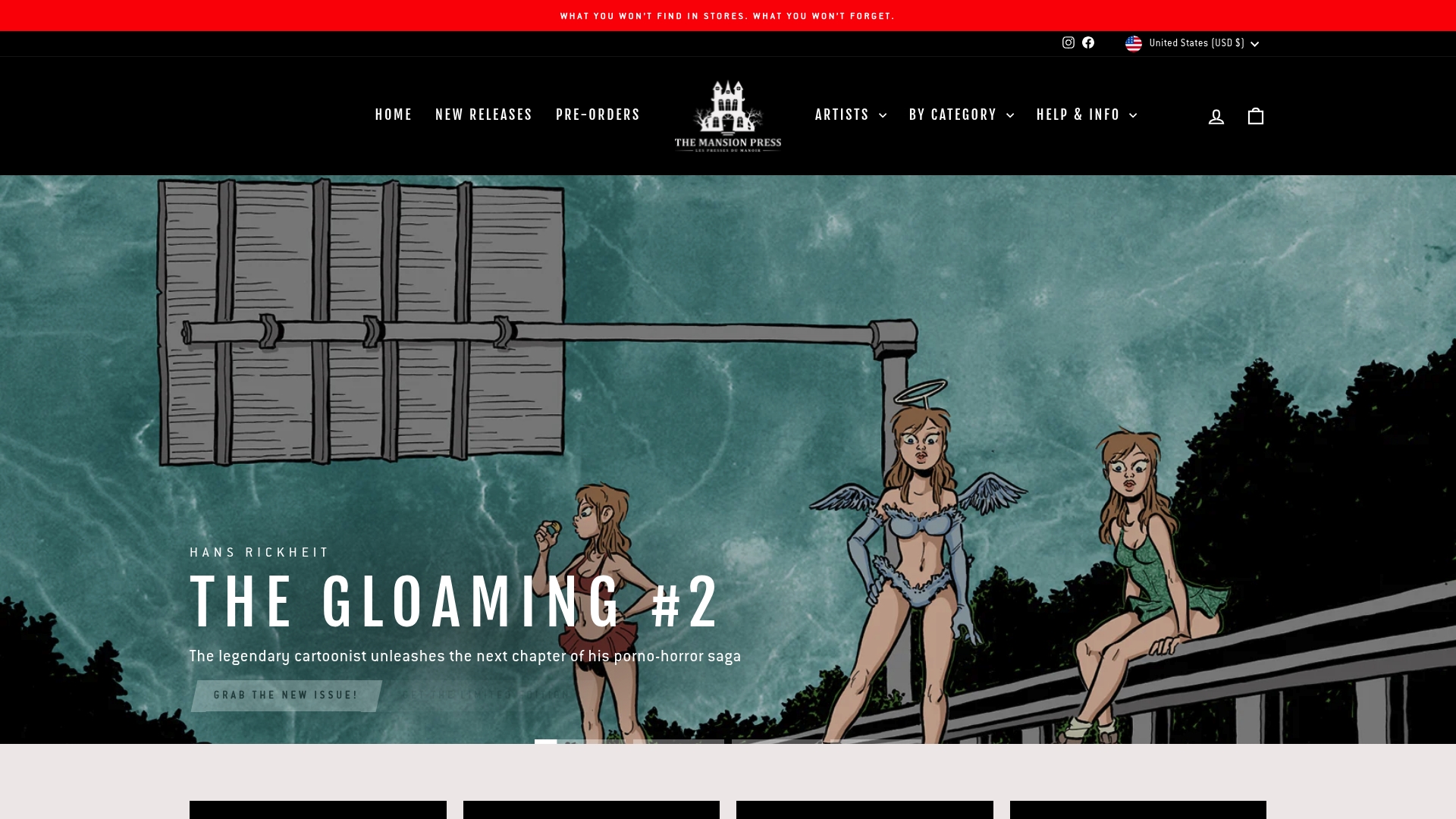What Is Visual Storytelling? Complete Guide for Artists
Did you know that our brains process visuals up to 60,000 times faster than text? This incredible speed shapes how we understand stories, making visual storytelling a vital part of how people connect ideas and emotions. From comics to digital art, the right imagery can turn complex concepts into clear, memorable experiences. Discover what sets effective visual storytelling apart and how artists craft images that stay with us long after we see them.
Table of Contents
- Defining Visual Storytelling And Core Concepts
- Key Types And Mediums Of Visual Storytelling
- Essential Elements And Techniques Used
- Real-World Examples And Notable Applications
- Common Challenges And How To Avoid Mistakes
Key Takeaways
| Point | Details |
|---|---|
| Visual Storytelling as a Universal Language | Visual storytelling transcends traditional communication by conveying complex narratives through imagery, engaging viewers on emotional and intellectual levels. |
| Core Elements of Visual Communication | Key components include composition, color psychology, character design, and emotional resonance, which collectively enhance narrative depth and viewer engagement. |
| Diverse Mediums for Storytelling | A wide array of artistic mediums, such as graphic novels, animated films, and photography, allow artists to craft multifaceted narratives that resonate across different platforms. |
| Navigating Challenges in Narrative Consistency | Artists must focus on maintaining narrative continuity and clarity to prevent visual fatigue and ensure effective storytelling through thoughtful visual connections. |
Defining Visual Storytelling and Core Concepts
Visual storytelling transforms complex narratives into compelling visual experiences, allowing artists to communicate profound ideas through imagery. According to Wikipedia’s Visual Narrative entry, this art form conveys stories primarily through visual media like illustrations, images, and films, leveraging graphic elements to communicate narratives effectively.
At its core, visual storytelling transcends traditional text-based communication, tapping into humanity’s fundamental understanding of narrative. The narrative paradigm suggests that humans inherently comprehend the world through stories, making visual narratives a powerful universal language. Artists using this approach create immersive experiences that engage viewers emotionally and intellectually by transforming abstract concepts into tangible visual representations.
The key components of visual storytelling include:
Here’s a comparison of core visual storytelling elements and their primary functions:

| Element | Description | Primary Function |
|---|---|---|
| Composition & Framing | Arrangement of visual elements | Guides viewer focus |
| Color Psychology | Use of color to evoke emotion | Sets mood & tone |
| Character Design & Body Language | Visual portrayal of characters | Expresses emotion & narrative |
| Sequential Progression | Ordering of images or scenes | Builds narrative flow |
| Emotional Resonance | Use of impactful imagery | Engages viewer emotionally |
- Composition and framing
- Color psychology
- Character design and body language
- Sequential visual progression
- Emotional resonance through imagery
Understanding these elements allows artists to craft narratives that speak directly to viewers’ imaginations. For a deeper exploration of narrative techniques, consider how each visual choice contributes to the overall storytelling experience.
Mastering visual storytelling requires more than technical skill it demands an intuitive understanding of how images communicate complex human experiences. By strategically arranging visual elements, artists transform simple illustrations into powerful emotional journeys that transcend linguistic and cultural boundaries.
Key Types and Mediums of Visual Storytelling
Visual storytelling encompasses a rich array of artistic mediums, each offering unique ways to communicate narrative experiences. According to research on sequential art, one of the most prominent forms is comic art, which uses a series of carefully arranged images to convey complex stories, allowing artists to create intricate narratives through strategic visual progression.
Beyond traditional comics, contemporary artists explore diverse storytelling techniques. Hybrid novels demonstrate how storytelling can transcend traditional boundaries by integrating multiple artistic elements like photography, illustrations, and poetry. These experimental approaches allow creators to craft multifaceted narratives that engage audiences through innovative visual communication.
The primary mediums of visual storytelling include:
- Graphic novels
- Comic books
- Animated films
- Storyboard illustrations
- Digital art sequences
- Photographic narratives
- Graphic memoirs
Experimental graphic storytelling techniques continue to push the boundaries of traditional narrative forms, challenging viewers to interpret visual language in increasingly sophisticated ways. Each medium offers artists unique opportunities to express complex emotional landscapes and human experiences through carefully crafted visual sequences.

Mastering visual storytelling requires understanding how different artistic mediums can transform abstract concepts into compelling visual journeys. Whether through intricate comic panels, evocative photographic series, or dynamic animated sequences, artists can create powerful narratives that speak directly to viewers’ imaginations and emotions.
Essential Elements and Techniques Used
Visual storytelling requires a sophisticated blend of artistic techniques that transform simple images into powerful narrative experiences. According to multimodal pedagogy research, effective storytelling integrates multiple communication modes, including visual, aural, and gestural elements to create rich, meaningful narratives that resonate with audiences.
At the heart of visual storytelling are fundamental compositional techniques that guide viewer perception and emotional engagement. These include strategic use of color, framing, perspective, and visual hierarchy. Graphical abstract techniques demonstrate how complex narratives can be distilled into concise, impactful visual summaries, showcasing the power of intentional visual communication.
Key elements of visual storytelling include:
- Composition and spatial relationships
- Color psychology and emotional tone
- Character body language and expression
- Symbolic and metaphorical imagery
- Rhythm and visual pacing
- Negative space and visual breathing room
- Narrative progression and visual flow
Understanding unique illustration styles allows artists to develop distinctive visual languages that communicate beyond traditional narrative constraints. Each visual choice becomes a deliberate storytelling tool, transforming static images into dynamic narrative experiences that speak directly to viewers’ emotions and imaginations.
Mastering visual storytelling is an intricate dance of technical skill and intuitive creativity. Artists must learn to balance visual complexity with clarity, creating works that invite viewers to explore, interpret, and connect with the underlying narrative through carefully crafted visual sequences.
Real-World Examples and Notable Applications
According to research from Nulab, visual storytelling spans an incredible range of creative mediums, from photography and cinema to video games and art installations. This versatility demonstrates how powerful visual narratives can communicate complex ideas across diverse platforms, engaging audiences through innovative storytelling techniques.
Cinematic visual storytelling represents one of the most sophisticated applications of this art form. As noted by design experts, groundbreaking films like ‘Spider-Man: Into the Spider-Verse’ showcase remarkable visual storytelling by utilizing bold color palettes, dynamic framing, and innovative layout designs that transform traditional narrative structures.
Notable applications of visual storytelling include:
- Documentary photography
- Animated films and series
- Interactive video game narratives
- Graphic novels and comics
- Social media content
- Virtual and augmented reality experiences
- Digital art installations
- Infographic design
- Marketing and advertising campaigns
Exploring unique illustration styles reveals how artists can push storytelling boundaries, creating immersive experiences that transcend traditional communication methods. Each medium offers unique opportunities to craft narratives that resonate emotionally and intellectually with audiences.
Mastering visual storytelling requires understanding how different platforms can transform abstract concepts into compelling visual journeys. Whether through intricate comic panels, dynamic film sequences, or interactive digital experiences, artists can create powerful narratives that speak directly to viewers’ imaginations and emotions.
Common Challenges and How to Avoid Mistakes
Research from ArXiv reveals that visual storytelling confronts significant challenges in generating coherent and imaginative narratives across image sequences. The primary obstacle for artists is maintaining narrative consistency while ensuring each visual element contributes meaningfully to the overall storytelling experience.
Narrative continuity represents the most critical technical challenge in visual storytelling. Advanced research suggests that bridging visual gaps between images requires sophisticated techniques like the ‘hide-and-tell’ model, which helps artists interpolate storylines and maintain a seamless narrative flow across different visual elements.
Common challenges artists encounter include:
- Maintaining visual consistency
- Managing narrative complexity
- Balancing detail with clarity
- Preventing visual fatigue
- Ensuring emotional resonance
- Avoiding narrative fragmentation
- Controlling viewer interpretation
Understanding experimental illustration techniques can help artists develop strategies to overcome these narrative obstacles. Successful visual storytellers learn to create deliberate visual connections that guide viewers through complex emotional landscapes without overwhelming their perceptual capabilities.
Mastering visual storytelling demands continuous practice and a nuanced understanding of how visual elements communicate. Artists must develop an intuitive sense of narrative progression, learning to use subtle visual cues that suggest movement, emotion, and context without relying on excessive exposition or complicated graphic designs.
Elevate Your Visual Storytelling with Unique Art Collections
Struggling to maintain narrative consistency and emotional resonance in your visual storytelling? The challenges of composition, color psychology, and sequential progression can feel overwhelming when you want to connect deeply with your audience. At The Mansion Press, we understand these pain points and offer exclusive access to artbooks, comics, and original artworks that inspire and fuel your creativity. Discover products that showcase masterful storytelling techniques and diverse artistic styles, giving you fresh perspectives to refine your own work.

Explore our curated selection today and transform your storytelling journey. Don’t wait to immerse yourself in the powerful narratives crafted by independent artists and comic creators from around the world. Visit The Mansion Press, browse our unique art collections, and find inspiration that speaks directly to your passion for visual storytelling.
Frequently Asked Questions
What is visual storytelling?
Visual storytelling is the art of conveying narratives through visual media like illustrations, images, and films, allowing artists to communicate complex ideas in an engaging way.
What are the essential elements of visual storytelling?
Key elements include composition and framing, color psychology, character design and body language, sequential visual progression, and emotional resonance through imagery.
What mediums can be used for visual storytelling?
Visual storytelling can be expressed through various mediums such as graphic novels, comic books, animated films, storyboard illustrations, digital art sequences, photographic narratives, and graphic memoirs.
What challenges do artists face in visual storytelling?
Artists often encounter challenges like maintaining narrative continuity, managing narrative complexity, balancing detail with clarity, and ensuring emotional resonance while avoiding visual fatigue.
Recommended
- Understanding Visual Narrative: The Art of Storytelling – The Mansion Press
- Overcoming the Challenge of Visual Storytelling in Art – The Mansion Press
- Understanding Storytelling Through Abstract Visuals – The Mansion Press
- Experimental Storytelling in Comics: Complete Guide – The Mansion Press
- Understanding Content Storytelling for Business Growth
- Créer un storytelling percutant pour engager votre audience


